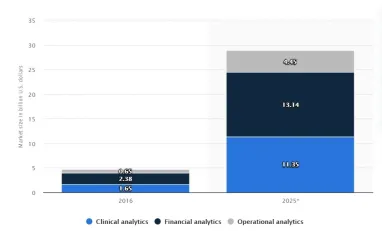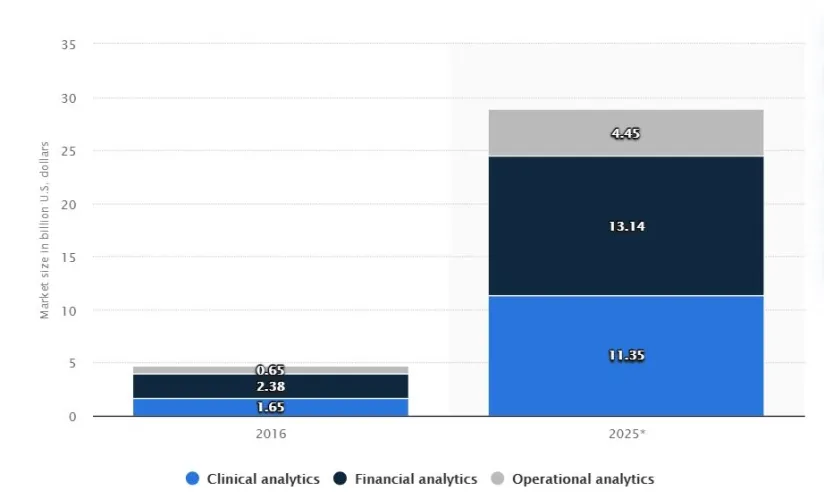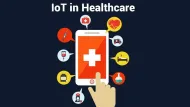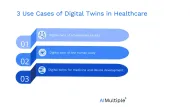Top 10 Healthcare Analytics Use Cases & Challenges in 2024


Healthcare-providing companies rely on analytics for clinical, financial, and operational improvement. Statistics suggest that by 2025 the market for health-related analytics will increase to ±$28 billion. We’ve explained before the benefits that healthcare companies gain by applying healthcare analytics, such as reducing analytics cost and improving patients outcomes. Find below the top use cases of analytics in healthcare:
1. Detecting fraud risk
Healthcare fraud (HCF) is a multibillion-dollar drain on healthcare spending, consuming an estimated $68 billion of annual healthcare spending in the United States. HCF can be attributed to deceitful practitioners, organized criminal schemes, or honest providers who make unintended mistakes during billing processes. Analytics can detect and predict fraud by:
- Analyzing claim patterns across different insurance policies or insurers
- Detecting upcoding (e.g. services that are unnecessary in light of the diagnosis)
- Discovering duplicate and phantom billing:
- A phantom bill is a claim submitted by a physician to the government to reimburse them for services they did not provide
- Unveiling phantom billing is done by comparing patient claims with prior medical history
2. Ensuring data security
Recent research by a cybersecurity firm claims that most surveyed healthcare organizations have experienced a data breach since 2016, which was projected to cost $4 billion by the end of 2019. Using analytics helps in minimizing security threats by:
- monitoring network traffic changes
- detecting susceptive cyber-attack behavior
- calculating real-time risk scores for specific transactions
Feel free to read more on how AI improves cybersecurity and our prioritized list of cybersecurity vendors.
3. Forecasting patient loads
The same way analytics are used to predict the number of people using transportation at a certain time of the day, analytics tools are being used to predict the number of patients visiting each department during specific times. This approach supports health facilities in:
- Managing resources (physicians and supporting staff)
- Reducing unnecessary labor cost
- Allocating a sufficient number of workers in accordance with workload
For example, the public university hospital in Paris utilized intel analytics platform to predict patient visits to the emergency department. The analytics platform allowed the users to view 15-day predictions of ER visits for optimizing staffing availability based on anticipated needs.
4. Monitoring real-time data
Real-time healthcare analysis provides the following benefits:
- Prevents adverse events:
- constantly analyzing data from in-hospital and in-home patient devices
- detecting alarms from bedside monitors
- Allows better resource planning by providing real-time data about
- number of patients and visitors
- available staff
- available operating rooms and patient beds
Clinical use cases
Other than operational and financial use cases, there are several clinical use cases. Most clinical use cases rely on patient data including family history, smoking habits, and health conditions and other patients’ outcomes and data:
5. Predicting disease outcomes
6. Predicting treatment plans
7. Predicting benefits of certain drugs
8. Prescription auditing
9. Tracking patient prescriptions and refills
10. Identify patient risk of substance abuse
Common Data Sources
Analytics is as good as the data source and typical data sources include healthcare providers’ own data, research results and EHR
Electronic Health Records (EHR)
Electronic health records (EHR) are the electronic version of a patient’s medical history which contains the patient’s:
- Diseases and allergies
- Medications and prescriptions
- Previous diagnoses
- Radiology images
- Treatment plan
- Test results
Challenges in integrating healthcare analytics
The key challenges in data analytics in healthcare are almost always related to cost, including:
Diversity in data formats
For example, in the US healthcare record digitization has been heavily subsidized by the federal and state governments. However, institutions blocking access and using different formats has slowed down interoperability of these records.
Typically, different medical facilities such as hospitals, pharmacies, and private clinics, use different medical software and data formats, which makes data comparison, analysis, transfer, and sharing more difficult.
Data storage
Medical facilities were estimated to generate ~2,000 exabytes of new healthcare data in 2020 rising from 153 exabytes in 2013. The massive size of healthcare data, as well as the different types of structured and unstructured data, increase the cost of storage.
Even though storage which offers slow access to data (e.g. storage systems like S3) is relatively cheap, running high computational loads on large amounts of data can be expensive.
Data technologies and staff
Medical organizations need to purchase analytics products and solutions. On the other hand, in order to handle healthcare data, specialized tech teams including data scientists and analysts need to be hired which can be quite costly depending on the size of the medical facility.
However, it is critical to choose the right analytics technology in healthcare due to the uniqueness of healthcare data and its measurement difficulty.
Which companies are providing healthcare analytics?
Companies such as IBM Watson, Flatiron Health, and Ayasdi are three of the top healthcare analytics vendors. You can learn more about their products in our article Top 10 Healthcare Analytics Companies: The Ultimate Guide
If you want to learn more about these companies, check out our data-driven list of healthcare analytics providers.
For more, feel free to read AI use cases in healthcare.
If you feel like you are ready to invest in healthcare analytics solutions, let us help guide you through the process:

Cem has been the principal analyst at AIMultiple since 2017. AIMultiple informs hundreds of thousands of businesses (as per similarWeb) including 60% of Fortune 500 every month.
Cem's work has been cited by leading global publications including Business Insider, Forbes, Washington Post, global firms like Deloitte, HPE, NGOs like World Economic Forum and supranational organizations like European Commission. You can see more reputable companies and media that referenced AIMultiple.
Throughout his career, Cem served as a tech consultant, tech buyer and tech entrepreneur. He advised businesses on their enterprise software, automation, cloud, AI / ML and other technology related decisions at McKinsey & Company and Altman Solon for more than a decade. He also published a McKinsey report on digitalization.
He led technology strategy and procurement of a telco while reporting to the CEO. He has also led commercial growth of deep tech company Hypatos that reached a 7 digit annual recurring revenue and a 9 digit valuation from 0 within 2 years. Cem's work in Hypatos was covered by leading technology publications like TechCrunch and Business Insider.
Cem regularly speaks at international technology conferences. He graduated from Bogazici University as a computer engineer and holds an MBA from Columbia Business School.
To stay up-to-date on B2B tech & accelerate your enterprise:
Follow on

Comments
Your email address will not be published. All fields are required.